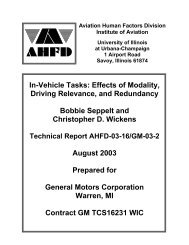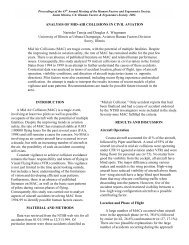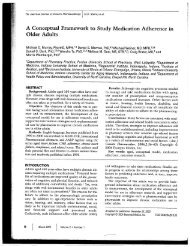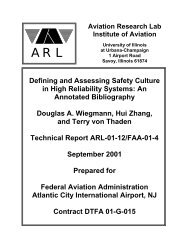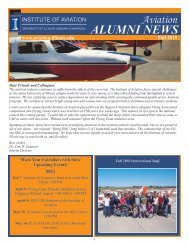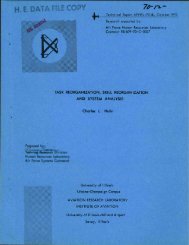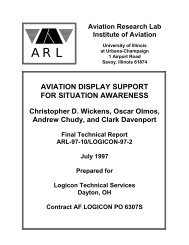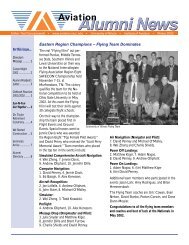Usability Questionnaire Results - Institute of Aviation - University of ...
Usability Questionnaire Results - Institute of Aviation - University of ...
Usability Questionnaire Results - Institute of Aviation - University of ...
You also want an ePaper? Increase the reach of your titles
YUMPU automatically turns print PDFs into web optimized ePapers that Google loves.
proximity would be diagnosing which capacitor will correct a voltage value problem since thisrequires integrating information across voltage values, buses, and location <strong>of</strong> capacitors.As was seen in the discussion <strong>of</strong> integrated displays, display proximity can be defined interms <strong>of</strong> either physical metrics or objectness (Wickens & Andre, 1990). The close spatialproximity display creates high display proximity by physically locating separate sources <strong>of</strong>information together as was seen in the example <strong>of</strong> the integrated one-line diagram where busesand their voltage values are placed next to each other. The object display capitalizes on thefeatures <strong>of</strong> an object to create high display proximity. As explained in the section on objectdisplays, objectness refers to the combination <strong>of</strong> two or more distinct dimensions into a singleobject that represents the two dimensions in an integral format (Barnett & Wickens, 1988;Carswell & Wickens, 1987).2.2.2.5 Proximity Compatibility PrincipleIn the designing <strong>of</strong> integrated displays, it needs to be determined where display elementsshould be located given their relatedness to other displays. The proximity compatibility principle(PCP) is one guideline that serves to glue all integrated displays together. The proximitycompatibility principle (PCP) has been closely examined and researched over the years (Barnett& Wickens, 1988; Bennett & Flach, 1992; Wickens & Andre, 1990; Wickens & Carswell, 1995).The principle states a relationship between task proximity and display proximity. The PCPasserts two basic display guidelines. If a task requires high processing proximity (taskproximity), then there should be high display proximity. Conversely, if a task requires lowprocessing proximity (task proximity), then there should be low display proximity. The moreintegrated information sources must be to perform a task, the more beneficial it will be to presentthose sources close together. This implies that integrated displays better support dividedattention tasks such as trend analysis or any other task where multiple sources <strong>of</strong> informationneed to be used.The predictions <strong>of</strong> the proximity compatibility principle have been investigated andsupported in varying contexts and have shown specific benefits for integrated displays. Theproximity compatibility principle has generally been well supported and the benefitsreproducible. In other research, Carswell and Wickens (1988) reviewed the literature oncomparative graphics. Of particular interest in this review were studies that compared differenttypes <strong>of</strong> integrated graphic formats such as line graphs and bar graphs. The review stated thatthe proximity compatibility principle generally applies well to graphs as is predicted by theprinciple. Since graphical displays integrate sources <strong>of</strong> information, they do support integratedtasks better than focused attention tasks.In another graph reading study, Goettl, Wickens, and Kramer (1991) have shown that themerits and costs <strong>of</strong> integral displays compared to separable displays depends on the task beingperformed. Their experiment required subjects to integrate information on speed and accuracydata for hypothetical experiments. Performance for this inference task was better when the datawere presented as two points or objects in a two-dimensional speed-accuracy space than as fourseparate bar graphs or objects presenting speed and accuracy for each condition separately. Incomparison, bar graph displays showed superiority when subjects were asked to perform a task13




